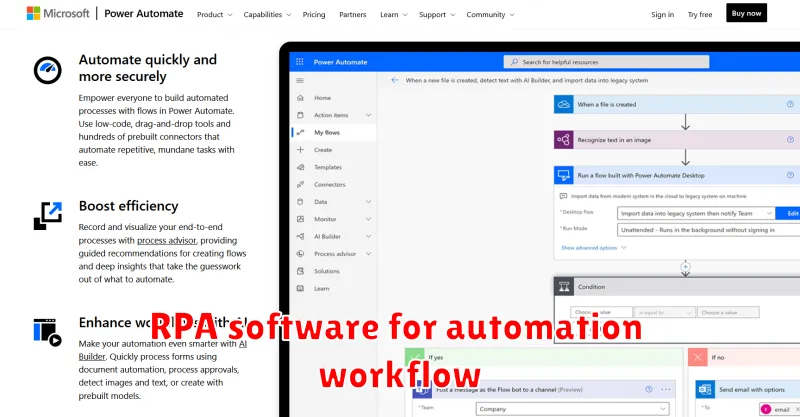In today’s fast-paced business world, efficiency is paramount. Companies are constantly seeking ways to streamline operations, reduce costs, and improve productivity. One powerful tool that can help achieve these goals is Robotic Process Automation (RPA) software. RPA empowers businesses to automate repetitive, rule-based tasks, freeing up valuable human resources for more strategic initiatives.
This comprehensive guide will delve into the world of RPA software, exploring its capabilities, benefits, and implementation strategies. Whether you’re a business leader looking to optimize your processes or simply curious about this emerging technology, this article will provide you with a thorough understanding of how RPA can unlock unprecedented efficiency and transform your operations.
What is Robotic Process Automation (RPA)?

Robotic Process Automation (RPA) is a technology that uses software robots, known as bots, to automate repetitive, rule-based tasks that are typically performed by humans. These bots mimic human actions, such as data entry, data extraction, and system interaction, but without the need for breaks, sleep, or emotions.
Imagine a virtual assistant that can work 24/7, tirelessly performing tedious tasks without errors. This is the essence of RPA. The bots are designed to automate processes across various departments, including finance, HR, IT, and customer service.
RPA is particularly beneficial for tasks that are:
- Repetitive: Tasks that involve recurring steps with little variation.
- Rule-based: Tasks that follow a predefined set of instructions.
- High-volume: Tasks that involve processing large amounts of data.
- Error-prone: Tasks that are susceptible to human errors.
By automating these tasks, RPA allows businesses to free up their workforce to focus on more strategic and complex activities, ultimately driving increased efficiency, productivity, and cost savings.
Benefits of Implementing RPA in Businesses
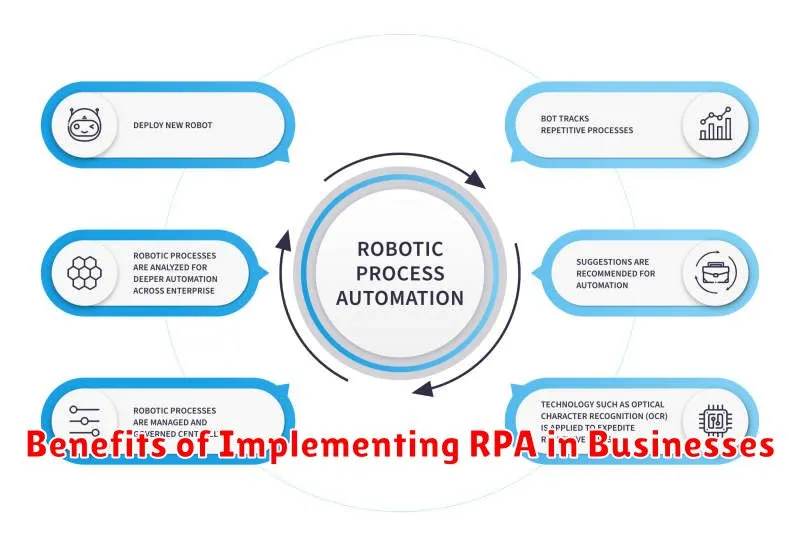
Robotic process automation (RPA) is rapidly becoming a key tool for businesses looking to improve efficiency and productivity. RPA software uses artificial intelligence (AI) and machine learning to automate repetitive tasks, freeing up human employees to focus on more strategic and creative work. Implementing RPA can deliver significant benefits to businesses across a wide range of industries.
One of the most significant benefits of RPA is increased efficiency. By automating repetitive tasks, RPA can help businesses to process information faster and with fewer errors. This can lead to significant cost savings and improved customer satisfaction. For example, RPA can be used to automate tasks such as data entry, invoice processing, and customer service inquiries.
Another key benefit of RPA is improved accuracy. Human error is a common problem in many businesses, but RPA can help to reduce this risk. RPA software is programmed to follow specific instructions and can perform tasks consistently and accurately. This can help to improve the quality of work and reduce the number of errors.
RPA can also help businesses to enhance compliance. By automating tasks that are subject to regulatory requirements, RPA can help to reduce the risk of errors and ensure that businesses are meeting all relevant standards.
Finally, RPA can help businesses to boost employee morale. By automating tedious and repetitive tasks, RPA can free up employees to focus on more challenging and rewarding work. This can lead to increased job satisfaction and motivation.

[object Object]
Identifying Processes Suitable for Automation
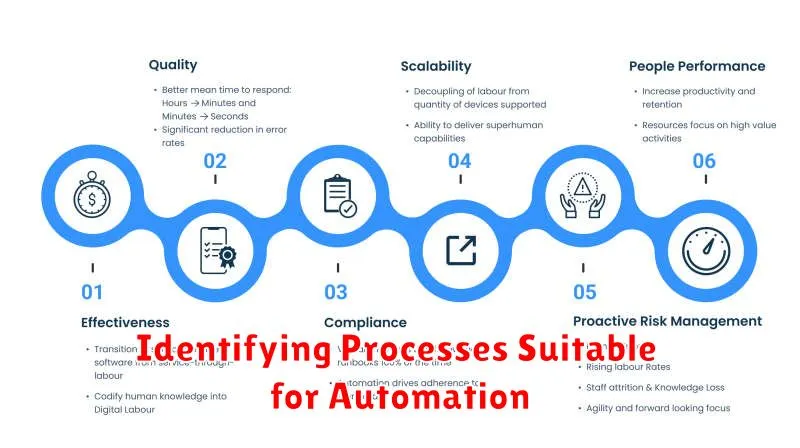
Before diving into the world of RPA software, it’s crucial to identify which processes within your organization are ripe for automation. Not every process is a good candidate, and choosing wisely will maximize your ROI. Here are some key factors to consider when evaluating processes for automation:
Repetitive and Rule-Based: The more repetitive and rule-based a process is, the better suited it is for automation. Look for tasks that involve the same steps, data input, or decision-making criteria every time.
High Volume: Processes with a high volume of transactions are ideal for automation. Imagine automating a process that is performed hundreds or thousands of times a day—the time savings are significant.
Error-Prone: Manual processes are prone to human error. Automating these processes can significantly reduce the risk of mistakes and ensure consistency in your outputs.
Time-Consuming: If a process takes up a significant amount of time for employees, automation can free them up to focus on more strategic tasks.
Data-Intensive: Processes that involve a lot of data manipulation, extraction, or integration are well-suited for automation. RPA tools are adept at handling large datasets and ensuring accuracy.
Costly: If a process is labor-intensive or requires specialized skills, automation can be a cost-effective solution in the long run.
By carefully identifying processes that meet these criteria, you can ensure that your automation efforts are focused on areas that will deliver the most value and efficiency.
Implementing and Deploying RPA Solutions

After the initial planning and design phase, the next step in the RPA journey is implementation and deployment. This phase brings the automated processes to life, ensuring they seamlessly integrate with existing systems and deliver tangible results.
Implementation involves configuring the RPA software, building the bots, and testing their functionality. This step requires close collaboration between the RPA team, business users, and IT professionals. The RPA team will leverage the previously defined workflows, scripts, and data mapping to configure the software and build the bots. This involves defining the steps each bot will take, setting triggers and conditions, and integrating with relevant systems and databases.
Deployment is the process of making the automated processes live and accessible to users. This involves deploying the bots to the production environment, ensuring they have access to the necessary resources, and monitoring their performance. Depending on the RPA platform and chosen deployment strategy, bots can be deployed centrally or decentralized.
Successful implementation and deployment of RPA solutions require careful planning and execution. Here are some key considerations:
- Choosing the Right Deployment Model: There are several deployment models, including on-premise, cloud, or hybrid. The choice depends on factors like infrastructure, security, and scalability requirements.
- Managing User Acceptance Testing (UAT): Extensive UAT is crucial to validate the bots’ accuracy, performance, and compliance with business requirements. This involves end-users actively testing the bots in a controlled environment before live deployment.
- Ensuring Security and Compliance: Robust security measures are essential for protecting sensitive data and maintaining regulatory compliance. Access controls, data encryption, and regular security audits are necessary.
- Monitoring and Maintenance: Continuous monitoring of bot performance, error logging, and regular updates are vital for ensuring ongoing efficiency and stability.
By carefully implementing and deploying RPA solutions, organizations can unlock significant efficiency gains, reduce errors, and improve overall productivity. The process requires a collaborative approach, meticulous attention to detail, and a commitment to continuous improvement.
Integrating RPA with Existing Systems
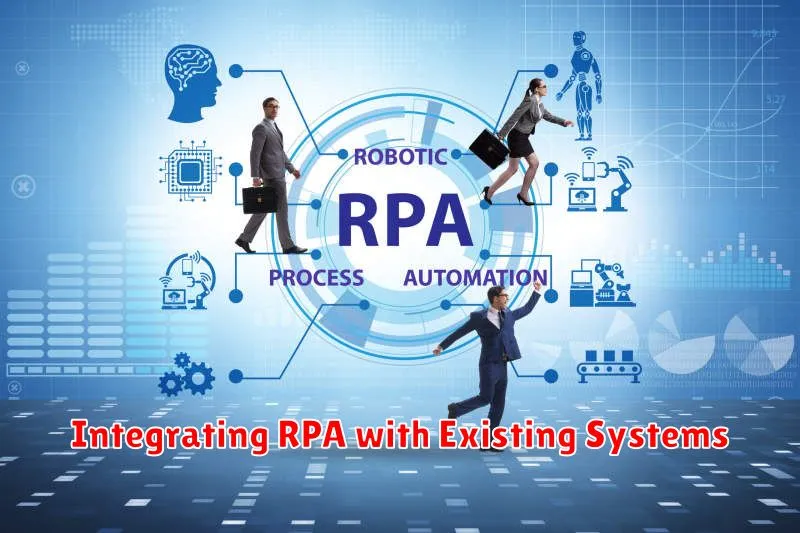
Integrating RPA with existing systems is crucial for realizing the full potential of automation. It involves seamlessly connecting RPA bots with your current infrastructure to automate tasks, access data, and trigger actions within your workflows. This integration ensures a smooth transition and maximizes the effectiveness of your RPA implementation.
There are several key considerations when integrating RPA with existing systems:
- System Compatibility: Ensure that your RPA solution is compatible with the systems you intend to automate. This includes factors like operating systems, databases, and application programming interfaces (APIs).
- Data Integration: Establish secure and reliable data exchange between the RPA bots and your existing systems. This involves defining data formats, ensuring data integrity, and handling data security measures.
- Security Considerations: Prioritize security during integration. Implement access controls, authentication mechanisms, and data encryption to protect sensitive information and prevent unauthorized access.
- Scalability and Flexibility: Design your integration architecture to be scalable and adaptable to future changes in your systems or business requirements.
Successful integration requires careful planning, collaboration between IT and business teams, and a clear understanding of your current systems and automation goals. By addressing these factors, you can unlock the full potential of RPA and achieve significant efficiency gains in your business operations.
Managing and Monitoring RPA Bots
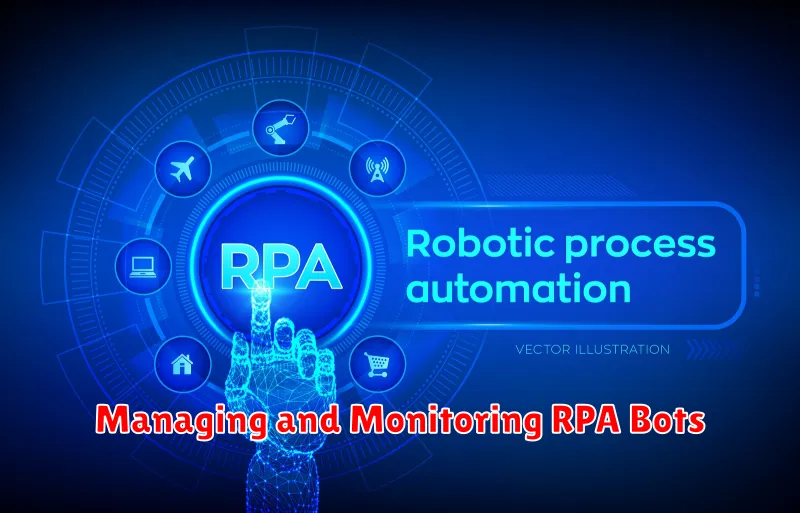
Once your RPA bots are up and running, it’s crucial to have a robust system for managing and monitoring them. This ensures smooth operation, identifies potential issues early, and maximizes the value of your automation investment.
Centralized Bot Management Platform: A dedicated platform provides a single point of control for managing your bot lifecycle. This includes deploying, scheduling, and updating bots, as well as tracking their performance and logs.
Real-time Monitoring: Monitoring tools provide insights into bot performance, such as execution time, success rate, and error logs. This enables you to proactively identify and address any issues, preventing disruptions to your automated processes.
Alerts and Notifications: Configure alerts and notifications for critical events, such as bot failures, system errors, or process delays. This ensures timely intervention and prevents issues from escalating.
Auditing and Logging: Maintain a detailed audit trail of bot activity, including execution history, data processed, and user actions. This provides transparency, accountability, and supports compliance requirements.
Performance Optimization: By analyzing bot performance data, you can identify areas for improvement and optimize bot configurations for efficiency and accuracy. This ensures your bots are running at peak performance and delivering maximum value.
Security Measures: Implement security measures to protect your bots and the data they handle. This includes access control, data encryption, and regular security updates.
Regular Maintenance: Schedule regular maintenance activities, including software updates, bot performance reviews, and system checks. This ensures the stability and reliability of your RPA infrastructure.
Effective management and monitoring are essential for maximizing the benefits of RPA. By implementing these practices, you can ensure your bots operate smoothly, deliver consistent results, and unlock the full potential of your automation journey.
Security and Compliance Considerations for RPA

As RPA adoption gains momentum, ensuring security and compliance is crucial. Implementing strong security measures is paramount to protect sensitive data and maintain regulatory compliance.
Data Security: RPA bots often access and process sensitive data. It’s essential to implement robust security measures, such as access controls, encryption, and data masking, to safeguard this data. Regular security audits and vulnerability assessments help identify and mitigate potential risks.
Authentication and Authorization: Securely authenticate and authorize bot access to systems and data. Utilize multi-factor authentication (MFA) and role-based access control (RBAC) to restrict access to authorized users and bots.
Compliance: RPA deployments must adhere to relevant regulations, such as GDPR, HIPAA, and SOX. Implement controls and processes to ensure compliance, including data retention policies, audit trails, and data breach notification procedures.
Risk Management: Conduct thorough risk assessments to identify potential security and compliance risks associated with RPA implementation. Develop mitigation strategies and implement appropriate controls to address these risks.
Vendor Security: Carefully evaluate the security practices of RPA vendors. Ensure they have robust security certifications and comply with industry standards.
By prioritizing security and compliance, organizations can unlock the full potential of RPA while mitigating risks and ensuring responsible automation.
Measuring the ROI of RPA Implementations
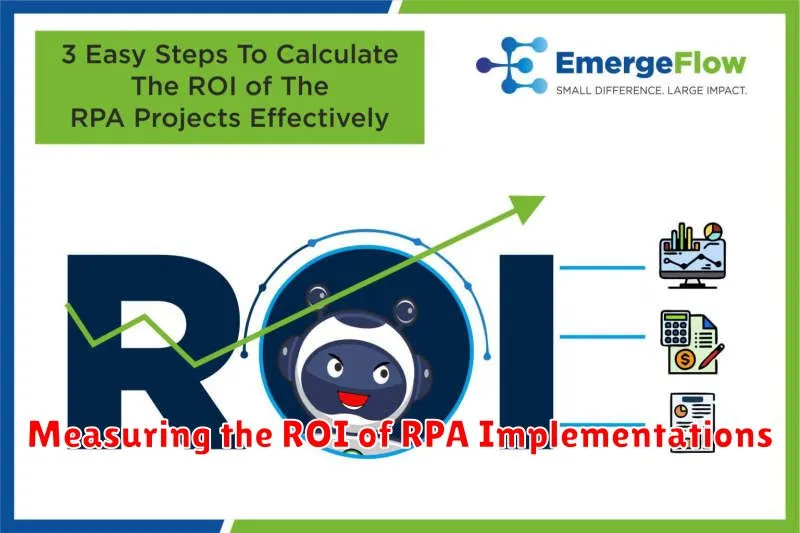
Implementing Robotic Process Automation (RPA) is a significant investment, and it’s crucial to measure its return on investment (ROI) to justify the expenditure and demonstrate its value. Determining the ROI of RPA requires a systematic approach that considers various factors and metrics.
Key Metrics for Measuring RPA ROI:
- Cost Savings: Calculate the reduction in labor costs by automating tasks previously performed by human employees. Analyze the time saved, the number of FTEs eliminated, and the associated salary costs.
- Increased Efficiency: Quantify the improvements in process speed and efficiency. Measure the reduction in processing time, the number of errors eliminated, and the overall throughput increase.
- Improved Accuracy: Assess the reduction in errors and the enhancement of data quality. Track the number of errors before and after RPA implementation and the resulting improvement in data integrity.
- Increased Productivity: Evaluate the impact on employee productivity and the ability to focus on higher-value tasks. Track the workload reduction, the number of tasks completed, and the overall increase in employee productivity.
- Enhanced Customer Satisfaction: Measure the improvement in customer service, response times, and overall satisfaction. Analyze customer feedback, satisfaction surveys, and service level agreements (SLAs) to gauge the impact of RPA on customer experience.
Calculating the ROI:
To calculate the ROI, divide the net benefits (cost savings, increased efficiency, etc.) by the total cost of implementing and maintaining RPA. The formula for calculating ROI is:
ROI = (Net Benefits / Total Cost) x 100%
Key Considerations:
- Project Scope and Complexity: The size and complexity of the RPA implementation will significantly impact the ROI.
- Software Costs and Maintenance: Factor in the cost of RPA software licenses, implementation services, and ongoing maintenance.
- Resource Allocation: Consider the time and resources required for project management, training, and ongoing support.
- Long-Term Benefits: Recognize that the ROI of RPA may not be immediately apparent but will accrue over time as the benefits compound.
By carefully measuring the ROI of RPA implementations, businesses can demonstrate the value of automation, optimize their investments, and drive continuous improvement in operational efficiency and customer satisfaction.
Case Studies: Successful RPA Use Cases
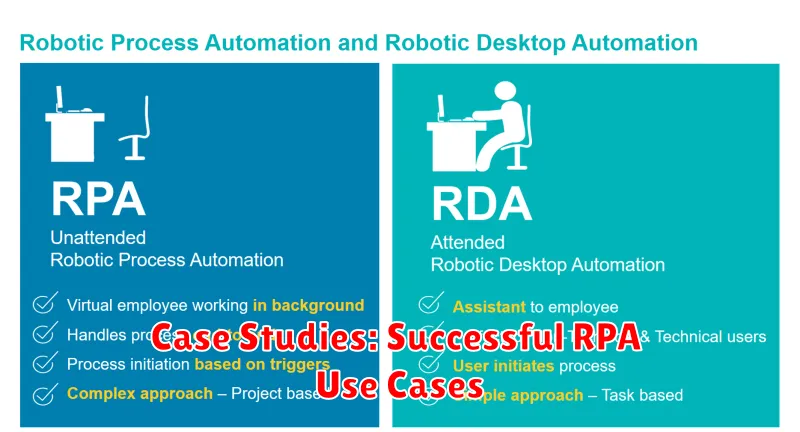
Robotic process automation (RPA) is transforming businesses across industries. To illustrate its real-world impact, let’s delve into compelling case studies showcasing the transformative power of RPA:
1. Boosting Efficiency in Customer Service at a Leading Bank
A major bank faced overwhelming customer service inquiries. By implementing RPA for tasks like account balance checks and basic transaction processing, they automated repetitive tasks, freeing up human agents to focus on more complex issues. This resulted in significantly reduced wait times and improved customer satisfaction.
2. Automating Claims Processing for an Insurance Company
An insurance company streamlined its claims processing workflow using RPA. By automating data entry, document validation, and claim routing, they achieved a remarkable 90% reduction in processing time. The process became more accurate and efficient, freeing up employees to focus on customer interaction and complex claim assessments.
3. Enhancing Order Fulfillment for an E-commerce Retailer
An e-commerce retailer implemented RPA to automate order processing, inventory management, and shipping tasks. This led to a 50% reduction in order fulfillment time, improved accuracy, and reduced operational costs. RPA enabled the company to handle a surge in orders during peak seasons without sacrificing efficiency or customer experience.
4. Streamlining Accounts Payable for a Manufacturing Firm
A manufacturing firm faced challenges with manual invoice processing. RPA was deployed to automate invoice data entry, matching, and payment approvals. This resulted in a 70% reduction in processing time, minimized errors, and enabled the finance team to focus on strategic analysis rather than tedious tasks.
5. Optimizing IT Support Processes at a Technology Company
A technology company used RPA to automate repetitive IT support tasks like password resets, software installations, and system updates. This freed up IT staff to focus on more complex troubleshooting and system administration, improving overall productivity and responsiveness.
These case studies demonstrate the wide range of applications for RPA across industries. From customer service and finance to IT and insurance, RPA is driving efficiency, accuracy, and cost savings, empowering businesses to unlock their full potential.
The Future of RPA and Intelligent Automation
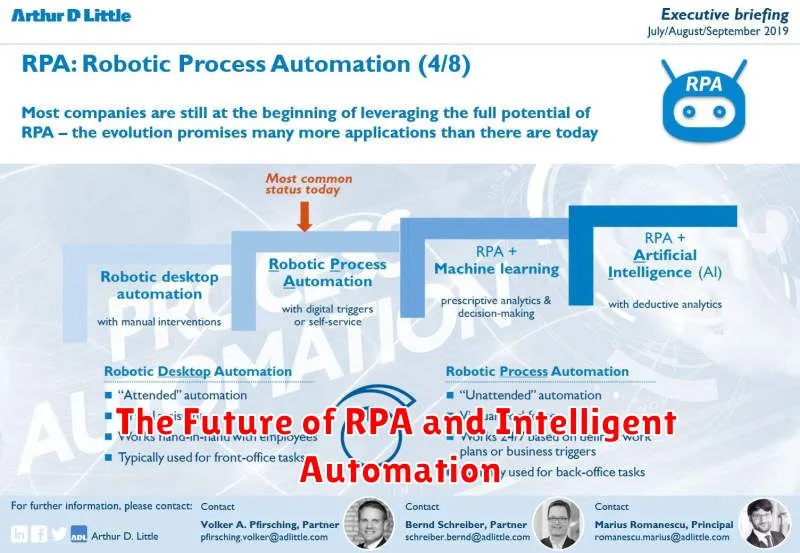
The future of Robotic Process Automation (RPA) and intelligent automation looks bright, as these technologies continue to evolve and disrupt various industries. RPA, which automates repetitive tasks, has already proven its value in streamlining processes and boosting productivity. But the future lies in its integration with artificial intelligence (AI) and other cutting-edge technologies. This integration will give rise to intelligent automation, where systems can learn, adapt, and make decisions, leading to even greater efficiency and effectiveness.
The confluence of RPA and AI will unlock new possibilities. AI-powered RPA will go beyond simple task automation to handle complex, data-driven processes. For example, it can analyze vast amounts of data to identify patterns and insights, predict future trends, and make informed recommendations. This capability can revolutionize decision-making across various sectors, including finance, healthcare, and manufacturing.
The future of RPA and intelligent automation is also about democratization. As these technologies become more accessible and user-friendly, even small businesses and individuals can leverage their power. This will enable a broader range of people to automate tasks, simplify workflows, and achieve their goals.
In the coming years, we can expect to see:
- Increased adoption of hyperautomation, where end-to-end processes are automated with minimal human intervention.
- More advanced AI models that can understand natural language, interpret complex data, and perform human-like tasks.
- The rise of cognitive automation, where machines can learn and adapt like humans, enabling them to handle even more complex processes.
The future of RPA and intelligent automation is exciting and full of potential. It’s a future where technology empowers individuals and businesses to achieve greater efficiency, productivity, and innovation.

